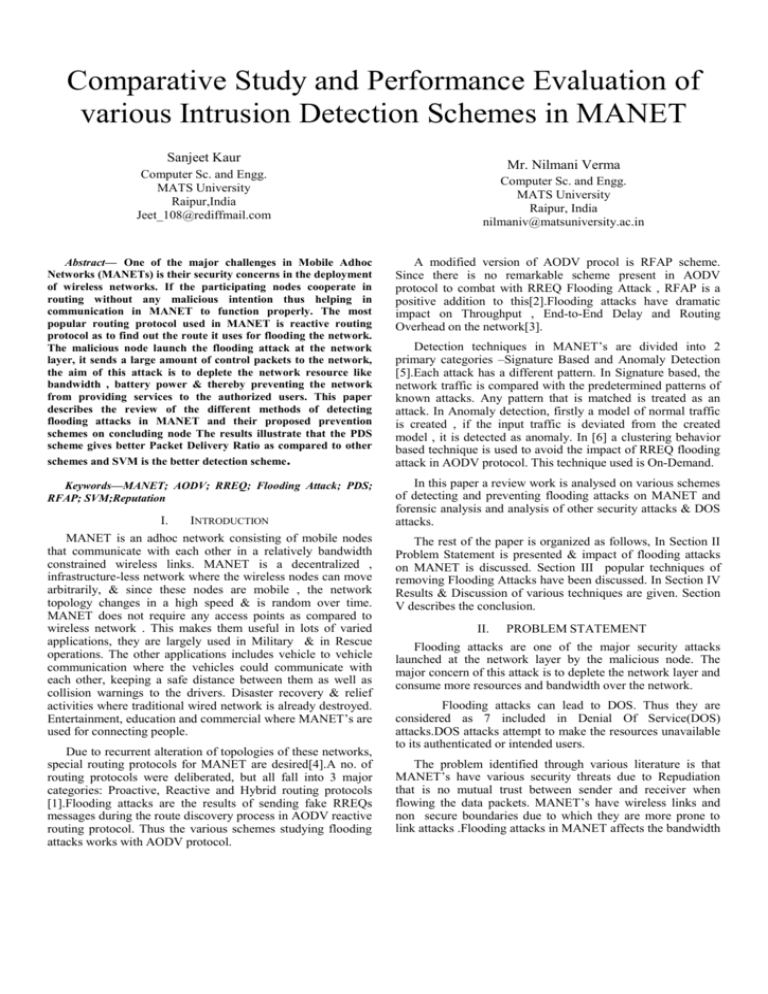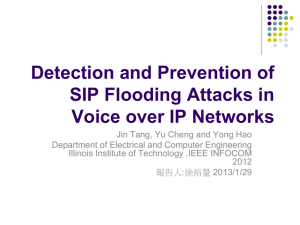Paper Title (use style: paper title)
advertisement

Comparative Study and Performance Evaluation of various Intrusion Detection Schemes in MANET Sanjeet Kaur Computer Sc. and Engg. MATS University Raipur,India Jeet_108@rediffmail.com Mr. Nilmani Verma Computer Sc. and Engg. MATS University Raipur, India nilmaniv@matsuniversity.ac.in Abstract— One of the major challenges in Mobile Adhoc Networks (MANETs) is their security concerns in the deployment of wireless networks. If the participating nodes cooperate in routing without any malicious intention thus helping in communication in MANET to function properly. The most popular routing protocol used in MANET is reactive routing protocol as to find out the route it uses for flooding the network. The malicious node launch the flooding attack at the network layer, it sends a large amount of control packets to the network, the aim of this attack is to deplete the network resource like bandwidth , battery power & thereby preventing the network from providing services to the authorized users. This paper describes the review of the different methods of detecting flooding attacks in MANET and their proposed prevention schemes on concluding node The results illustrate that the PDS scheme gives better Packet Delivery Ratio as compared to other schemes and SVM is the better detection scheme. A modified version of AODV procol is RFAP scheme. Since there is no remarkable scheme present in AODV protocol to combat with RREQ Flooding Attack , RFAP is a positive addition to this[2].Flooding attacks have dramatic impact on Throughput , End-to-End Delay and Routing Overhead on the network[3]. Keywords—MANET; AODV; RREQ; Flooding Attack; PDS; RFAP; SVM;Reputation In this paper a review work is analysed on various schemes of detecting and preventing flooding attacks on MANET and forensic analysis and analysis of other security attacks & DOS attacks. I. INTRODUCTION MANET is an adhoc network consisting of mobile nodes that communicate with each other in a relatively bandwidth constrained wireless links. MANET is a decentralized , infrastructure-less network where the wireless nodes can move arbitrarily, & since these nodes are mobile , the network topology changes in a high speed & is random over time. MANET does not require any access points as compared to wireless network . This makes them useful in lots of varied applications, they are largely used in Military & in Rescue operations. The other applications includes vehicle to vehicle communication where the vehicles could communicate with each other, keeping a safe distance between them as well as collision warnings to the drivers. Disaster recovery & relief activities where traditional wired network is already destroyed. Entertainment, education and commercial where MANET’s are used for connecting people. Due to recurrent alteration of topologies of these networks, special routing protocols for MANET are desired[4].A no. of routing protocols were deliberated, but all fall into 3 major categories: Proactive, Reactive and Hybrid routing protocols [1].Flooding attacks are the results of sending fake RREQs messages during the route discovery process in AODV reactive routing protocol. Thus the various schemes studying flooding attacks works with AODV protocol. Detection techniques in MANET’s are divided into 2 primary categories –Signature Based and Anomaly Detection [5].Each attack has a different pattern. In Signature based, the network traffic is compared with the predetermined patterns of known attacks. Any pattern that is matched is treated as an attack. In Anomaly detection, firstly a model of normal traffic is created , if the input traffic is deviated from the created model , it is detected as anomaly. In [6] a clustering behavior based technique is used to avoid the impact of RREQ flooding attack in AODV protocol. This technique used is On-Demand. The rest of the paper is organized as follows, In Section II Problem Statement is presented & impact of flooding attacks on MANET is discussed. Section III popular techniques of removing Flooding Attacks have been discussed. In Section IV Results & Discussion of various techniques are given. Section V describes the conclusion. II. PROBLEM STATEMENT Flooding attacks are one of the major security attacks launched at the network layer by the malicious node. The major concern of this attack is to deplete the network layer and consume more resources and bandwidth over the network. Flooding attacks can lead to DOS. Thus they are considered as 7 included in Denial Of Service(DOS) attacks.DOS attacks attempt to make the resources unavailable to its authenticated or intended users. The problem identified through various literature is that MANET’s have various security threats due to Repudiation that is no mutual trust between sender and receiver when flowing the data packets. MANET’s have wireless links and non secure boundaries due to which they are more prone to link attacks .Flooding attacks in MANET affects the bandwidth of the network ,as communication bandwidth gets fatigued by the flooded RREQ packets. Resource consumption is more because of flooded nodes, limitation of storage requirements as because of fake RREQ packets which flood the network leads to congestion in network and overflow of route table in the intermediate nodes so that the nodes cannot receive the new RREQ packets. III TECHNIQUES ATTACKS FOR MITIGATING FLOODING A. PDS-Profile Based Detection SchemeThis technique aims at detecting the flooding attack on MANET. This approach detects the misbehaving nodes and isolates them using a dynamic profile based traffic analysis. The PDS approach has2 phases of operations Detection phase and Isolation phase. The PDS system architecture is having a set of modules which tries to quantify the normal behaviour of the nodes and then identifies the abnormal behaviour of the malicious nodes. 1)Flooding ModeIn this mode the attacker performs actively.In the network few nodes are made malicious while the other nodes operate in normal AODV mode. The malicious nodes starts sending the fake and bogus RREQ packets without complying to the rate limit parameter. As soon as the malicious node start sending the packets, the normal functioning of the network degrades. 2)Detection ModeThis mode aims & concentrates on detecting the malicious node which sends the bogus or fake RREQ packets. The Profile table of each node stores the threshold value based on the rate limit parameter. Each receiving node, before forwarding the RREQ to its neighbour would check with its profile table. The profile table is assumed to be password protected & it cannot be accessed by the attackers. The threshold values stored in profile tables are dynamic enough to detect the attackers as soon as possible. 3)Isolation ModeThe attackers detected in the detection mode should be isolated from participating in communication inside the network. If attackers are not isolated they would continue with their behaviour and thereby depletes the network resources and decreases the network performance. The attackers detected are made passive that is their radio interfaces(sending and receiving) are made down so that they cannot actively participate on the network. 4)Performance ModeFor normal AODV operation, flooding operation and detection mode, the network parameters are captured.The performance of the same is analysed so that the effect of flooding attacks can be known and to know the effectiveness of the proposed scheme. B. Support Vector Machine(SVM) schemeIn this method initially the behaviour of every node is collected and then the flooded malicious node is detected using this data. This collected behavior of each node is passed through the SVM and checked this to the threshold limit, to find if the node cross the threshold limit they are detected as malicious node. The parameters used for behavior classification using SVM are: 1) Packet Delivery Ratio(PDR) PDR= (Number of Packet's Transmitted)/ (Total Number of Incoming Packets) 2) Control Overhead(CO) CO=(Number of Control Packet’s Transmitted)/(Total Number of Packets) 3) Packet Misroute Rate(PMIR) PMIR=(Number of Packet's Misrouted)/ (Total Number of Incoming Packets) Prevention Method- For prevention of flooding attacks the SVM will be installed on some node for the detection of malicious node after detection this node broadcast the acknowledgement message to all the other nodes, then all the nodes update their routing table and delete the entries of the malicious node . C. Route Request Flooding Attack Prevention(RFAP) SchemeThe RFAP is a scheme that mitigates the RREQ flooding attack in MANET. This scheme first find the flooder or malicious node, isolates it from the network , gives some punishment and after reasonable punishment reconsiders the node as an accuse node. Majority of the schemes proposed by the researchers find the attacker node then blacklist the node forever. The RFAP scheme totally disagrees with the idea that if a node misbehaves, just segregate it from the network. The scheme believes that a flooder node may be misused by the intruder and is normalized thereafter by changing its position extraordinarily.The RFAP scheme is designed to provide enough time to the malicious node to come to a normal routine. The RFAP is an amended form of AODV protocol. This scheme is specially designed for MANET that has higher node mobility. The main objective of this scheme is the recovery of malicious nodes after reasonable punishment. The results illustrates that RFAP scheme has the ability to separate the flooder node from the network more reliably than the simple AODV. D. Group Mobility for Defending MANET’s against Flooding AttacksIn this a clustering behavior based technique is used for avoiding the impact of RREQ flooding attacks in AODV protocol. When mobility model is used in Group Mobility, they have many advantages when the nodes are arranged in clusters. These clusters form the backbone of the network. This clustering technique is On-Demand , the node replies with the RREP will be elected as cluster head. The behavior of each node is calculated using the Reputation formula, on the basis of which maximum no. of RREQ to be sent is decided for each node. The formula used: RAi = (RREPi+k) /RREQi IV. allowed_RREQi= RAi * max_RREQi On the basis of calculated Reputation, the nodes are made to send RREQs. A new parameter K is being introduced to avoid clustering overhead, because some RREQ packets are dropped due to cluster head bottlenecks. The technique illustrates that any malicious node cannot send packets at high rate because reputation value will be less. A filtering scheme is used to avoid false detection in which reputation of all nodes are calculated again after the HELLO time interval, if a nodes reputation is 0 it will be increased to 0.1. The reputation value increases if a node starts behaving like a genuine node & it is given a chance to join the network again as genuine node. III. The network layer is largely overwhelmed with different security attacks due to the fact that MANET’s nodes acts as hosts and routers at the same time and this requires cooperation between nodes. It is discussed that the flooding attacks is one of the major security attack in network layer of MANET and various popular techniques for the detection and prevention of flooding attacks in MANETs have been discussed in this paper. REFERENCES [1] [2] RESULTS & DISCUSSIONS In this paper different techniques for mitigating the flooding attacks on MANET’S have been discussed and the table below shows the effect on Packet Delivery Ratio (PDR) and compared the PDR of different techniques, when there are number of attacking nodes present in the network. [3] Table I shows that the PDS scheme shows the best result ,it detects the attacker as soon as the attacker node starts exhibiting its abnormal behaviour.PDS detects and isolates the attacker node efficiently with better PDR. The result also shows that the SVM technique uses the best detection algorithm. [5] TABLE I. EFFECT ON PDR [7] No. of Attacking Nodes Technique 1 Technique 2 Technique 3 Technique 4 10 0.80 0.50 Avg PDR 0.25 20 0.85 0.40 Avg PDR 0.15 30 0.86 0.30 Avg PDR 0.1 40 0.90 0.28 Avg PDR 0.05 50 0.95 0.20 Avg PDR 0.01 CONCLUSION [4] [6] Effect on PDR using different techniques [8] Meenakshi Patel, Sanjay Sharma and Divya Sharan ,“Detection and Prevention of Flooding Attack Using SVM” , IEEE 2013 (CSNT)International Conference on Communication Systems and Network Technologies. Kashif Laeeq,”RFAP, A Preventive Measure against Route Request Flooding Attack in MANETS”, Proceedings of Multitopic Conference (INMIC), Dec 2012 IEEE 15th International Conference. Mohamed A. Abdelshafy and Peter J.B King,” Analysis of Security Attacks on AODV Routing”, Proceedings of Internet Technology and Secured Transactions (ICITST) Dec 2013 IEEE,8th International Conference. Luis Girones Quesada, “Routing Protocol for MANET’s”,Norwegian University of Science & Technology. Fatemeh Barani and Sajjad Gerami ,” ManetSVM: Dynamic Anomaly Detection using Oneclass Support Vector Machine in MANETs” , Proceedings of Information Security and Cryptology(ISCISC)2013 IEEE 10TH International Conference Aug 2013. Taranpreet Kaur, Amanjot Singh Toor and Krishan Kumar Saluja ,” Defending MANETs against Flooding Attacks for Military Applications under Group Mobility”, Proceedings of 2014 RAECS VIET Panjab University Chandigarh, 06 - 08 March, 2014 IEEE. Sarah Ahmed & S.M. Nirkhi , ” A Fuzzy Approach for Forensic Analysis of DDOS Attacks in MANET” , International Conference on Computer Science and Information Technology, 10th, March 2013, Hyderabad. Bhuvaneshwari K and Dr. A.Francis Saviour Devaraj, “PDS- A Profile based Detection Scheme for flooding attack in AODV based MANET”, International Journal of Security ,Privacy and Trust Management(IJSPTM) vol 2,No.3,June 2013.






